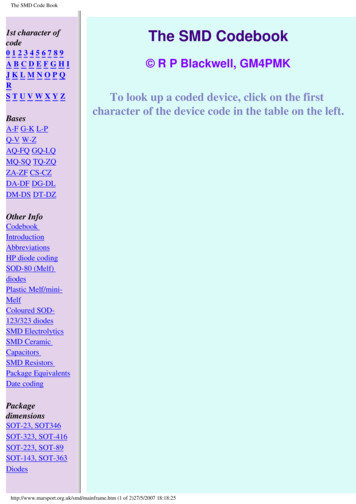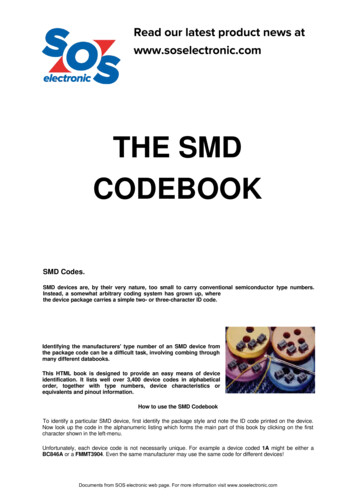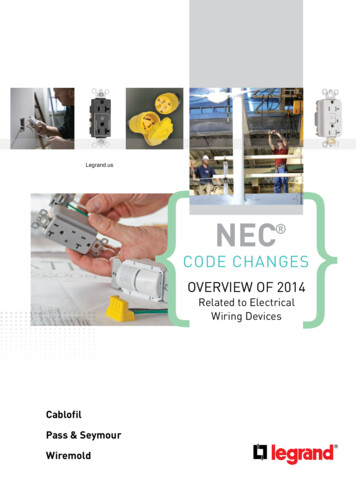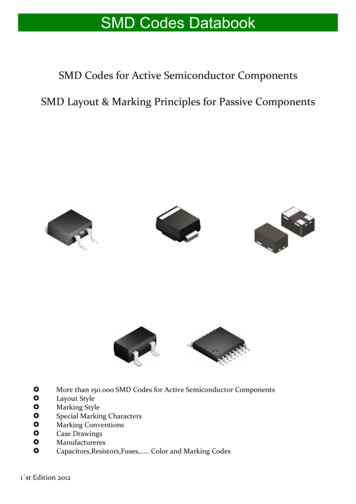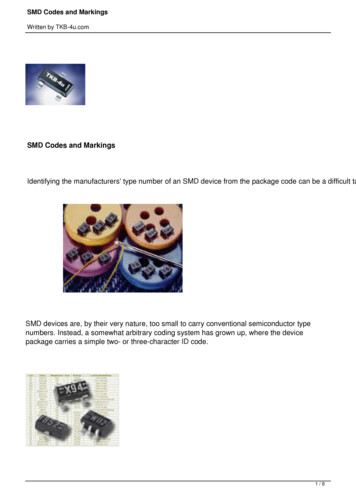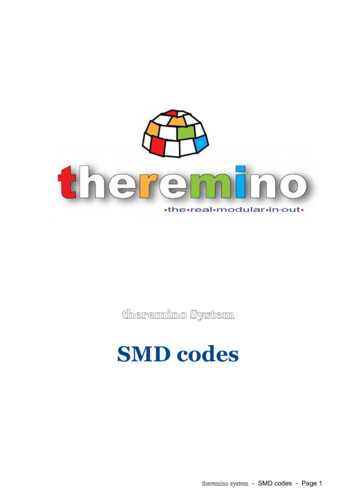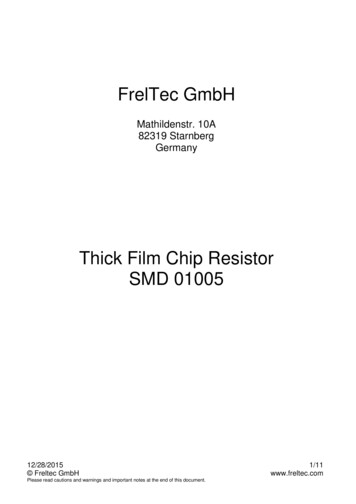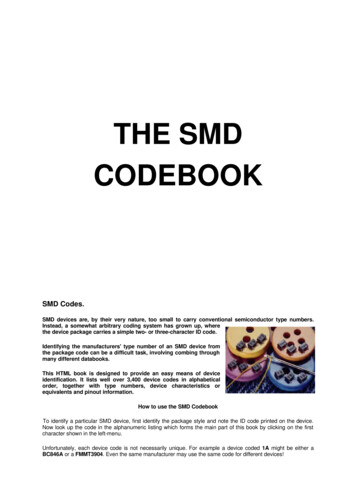
Transcription
THE SMDCODEBOOKSMD Codes.SMD devices are, by their very nature, too small to carry conventional semiconductor type numbers.Instead, a somewhat arbitrary coding system has grown up, wherethe device package carries a simple two- or three-character ID code.Identifying the manufacturers' type number of an SMD device fromthe package code can be a difficult task, involving combing throughmany different databooks.This HTML book is designed to provide an easy means of deviceidentification. It lists well over 3,400 device codes in alphabeticalorder, together with type numbers, device characteristics orequivalents and pinout information.How to use the SMD CodebookTo identify a particular SMD device, first identify the package style and note the ID code printed on the device.Now look up the code in the alphanumeric listing which forms the main part of this book by clicking on the firstcharacter shown in the left-menu.Unfortunately, each device code is not necessarily unique. For example a device coded 1A might be either aBC846A or a FMMT3904. Even the same manufacturer may use the same code for different devices!
If there is more than one entry, use the package style to differentiate between devices with the same ID code.This compilation has been collected from R P Blackwell G4PMK, manufacturers' data and other sources of SMDdevice ID codes, pinout and leaded device equivalent information.The entries under the Manufacturer column are not intended to be comprehensive; rather they are intended toprovide help on locating sources of more detailed information if you require it.ID Code VariationsMany manufacturers use an extra letter as their own identification code. If the device is from Philips it willsometimes have a lower case 'p' (or sometimes 't') added to the code; Siemens devices usually have a lowercase 's'.For example, if the code is 1A, according to the table there are a number of possibilities: 1A BC846A Phi ITT N BC546A1A FMMT3904 Zet N 2N39041A MMBT3904 Mot N 2N39041A IRLML2402 IR F n-ch mosfet 20V 0.9AThis has been a problem in the past, however recently manufacturers have been adding lower case letterswhich clarify the code.Many recent Motorola devices have a small superscript letter after the device code, such as SAC . (This smallerletter is merely a month of manufacture code.)Many devices from Rohm Semiconductors which start with G have direct equivalents found in the rest of thenumber. For example GD1 is the same as D1 which is a BCW31.Some devices have a single coloured letter (usually on extremely small diode packages). Colour, if significant, isshown in small type after the code letter.An 'L' suffix usually indicates a low-profile package, such as an SOT323 orSC70.SOT323.SC70.Reverse joggle devices do present a few problems. They oftern have an 'R' in the type number. A reversepackage is one where the lead have been bent up instead of down. So it's a mirror image of a conventionaldevice. Identification is usually possible from the code number, but some manufacturers use the same code. Inthese cases, it's a case of looking at the device with a magnifying glass. The leads of most normal packagescome out closer to the circuit board side of the device; conversely a reverse joggle package will have themcoming out closer to the 'top' of the device.Sometimes a series of devices, derived from the same die, have related type (not code) numbers. Often an 'R' willindicate a reverse joggle package, and/or a 'W' indicate a smaller package variant, such as SOT343.Sometimes similarities are also found in the code numbers. For example:Recently some manufacturers have used a symbol or lower case letter to indicate the country of manufacture.These have been ignored in the alphabetical ordering. For example:
'67' is the code for a BFP67 (SOT143 package) ,'67R' is the code for the reverse joggle variant BFP67R (SOT143R),'W67' is the code for a SOT343 package version.SOT143.'Z-S' and 'ZtS ' are both 2PC4081Q devices made by Philips; the first made in Hong Kongand the second in Malaysia; this appears in the codebook classified under ZS.Leaded equivalent device and informationWhere possible, the listing gives the part number of a conventional wire-leaded device with equivalentcharacteristics. If the leaded device is well-known then no more information is given. If the device is less common,some additional information will sometimes be given. Where no exact leaded equivalent exists, a brief devicedescription is given, which may be sufficient to allow substitution with another device.When describing device characteristics, some terms are implied from the type of device. For example, a voltagespecified for a rectifier diode is usually the maximum PIV (peak inverse voltage) of the diode, but for a zenerdiode the operating (zener voltage) will be given.Normally, where a voltage, current or power is specified, these will be limiting values. For example, a devicespecified as NPN 20V 0.1A 1W is a NPN transistor with a Vce (max) of 20V, maximum collector current of 100mAand a maximum total power dissipation of 1W. Some of the transistors are types with integrated resistors; in thelist, a base resistor means a resistor connected in series with the base. When two resistor values are given, thefirst is the series base resistor, and the second the resistor between base and emitter.Digital Transistors (dtr)These are transistors with built-in resistors.Some have one resistor between base and emitter, others in series with the base. Many others have both.To keep things simple, the series resistor is called R1 and the base emitter resistor is called R2. If both arepresent, then two values are given, R1 first. So 4k7 10k means that R1 (the base resistor) is 4k7 and R2 (theresistor between base and emitter) is 10k.ConclusionIdentifying the manufacturers' type number of an SMD device from the package code can be a difficult task,involving combing through many different databooks. This HTML book is designed to provide an easy means ofdevice identification.
eccathodecacommon anodecccommon cathodecompcomplementddraindgdual gatedtrdigital transistor (see codebook introduction)enhenhancement (mode - FETs)fetfield effect transistorfTtransition frequencyGaAsfetGallium Arsenide field effect transistorggategndgroundgpgeneral purposehfesmall signal current gaini/pinputIddrain currentIggate currentIrreverse leakage current (diodes)
jfetjunction field effect transistorMAGmaximum available gainmaxmaximumminminimummmicmicrowave minature integrated circuitmodampmodular amplifier - an mmic amplifiermosfetmetal oxide insulated gate fetn-chn-channel fet (any type)npnnpn bipolar transistoro/poutputp-chp-channel fet (any type)pinpin diodepkgpackagepnppnp bipolar transistorprotprotection, protected (as in mosfet strateswswitch or switchingVcecollector - emitter voltage (maximum)Vcccollector supply voltageManufacturer abbreviationsAgiAgilent (was HP)FchFairchildHPHewlett-Packard (Now Agilent)InfInfineon (was Siemens)ITTITT SemiconductorsMCMini-CircuitsMotMotorola (now ON Semiconductors)NatNational SemiconductorNecNECNJRCNew Japan Radio CoONON Semiconductors (was s (now Infineon)SilSiliconix (Vishay-Silliconix)TemTemic SemiconductorsTfkTelefunken (Vishay-Telefunken)TokToko Inc.ZetZetex
Codes beginning with OT173Leaded Equivalent/DataNpn RF fT 70SC59SOT143SOT89SOT323PAD-5 5pA leakage diodepnp dtr 4k7 4k7pnp dtr 4k7 4k7DC-8GHz MMIC amp 12dB gainPAD-10 10pA leakage diode2N2369n-ch mosfet 80V 175mAnpn RF MRF57150V 100mA npn sw 10k base resDC-8GHz MMIC amp 16dB gainnpn 4k7 4k7 bias resnpn 4k7 4k7 bias resDC-3GHz MMIC amp 22dB gainnpn dtr R1 4k7 50V 100mAnpn dtr R1 4k7 50V 100mAnpn dtr R1 4k7 50V 100mAnpn dtr R1 10k 50V 100mAnpn dtr R1 10k 50V 100mAnpn dtr R1 10k 50V 100mAnpn dtr R1 10k 50V 100mApnp RF MRF521DC-4GHz MMIC amp 17.5 dBm2N3904
363SOT363SOT363SOT363SOT3632N3904DC-4GHz MMIC amp 18 dBm o/pnpn dtr R1 22k 50V 100mAnpn dtr R1 22k 50V 100mAnpn dtr R1 22k 50V 100mAfT12GHz npn 4V 5mADC-4GHz MMIC amp 115 dBm o/pnpn dtr R1 47k 50V 100mAnpn dtr R1 47k 50V 100mAnpn dtr R1 47k 50V 100mA2N39062N3906PAD-20 20pA leakage diodePAD-50 50pA leakage diode2N2369Anpn dtr R2 100k 50V 100mAnpn dtr R2 100k 50V 100mAdual pnp dtr 10k 10knpn dtr R2 100k 50V 100mAnpn dtr R2 100k 50V 100mAdual pnp dtr 22k 22kdual pnp dtr 47k 47kdual pnp dtr 10k 47kdual pnp dtr R1 10kdual pnp dtr R1 4k7dual pnp dtr 1k0 1k0dual pnp dtr 2k2 2k2dual pnp dtr 4k7 4k7dual pnp dtr 4k7 47kdual pnp dtr 22k 47kdual pnp dtr 2k2 47kCodes beginning with '1'Code111 SC70SC59SOT23Leaded Equivalent/Datanpn RF fT10GHzVHF Tuner band switch diode56-2.7 pF varicapnpn Rf 8GHz MRF941dual ca 10V 0.3W zener10V 0.3W zener10V 1W zenernpn RF 8GHz MRF951npn/pnp dtr 10k 10kpnp dtrpnp dtrpnp dtrdual ca 11V 0.3W zenerSi diode 200V 100mA11V 0.3W zener11V 1W zenernpn/pnp dtr 22k 22kpnp dtr 2k2 2k2 50V 100mapnp dtr 2k2 2k2 res 50V 100manpn dtrnpn dtrSi diode 200V 100mAdual ca 12V 0.3W zenerdual series RF schottky15V 20mA12V 0.3W zener12V 1W zenerpnp dtr 4k7 4k7 50V 100mapnp dtr 4k7 4k7 50V 100mapnp dtr 4k7 4k7 50V 100ma
SOT346SC70SOT346SC70SOT346BC546BSchottky sw 24V 100mASchottky sw 24V 100mASchottky RF 20V 100mAnpn/pnp dtr 47k 47kdual Si diode 200V 100mAdual ca 13V 0.3W zenerdual ca RF schottky15V 20mA13V 0.3W zener13V 1W zenerDual series Schottky 25V 100mADual series Schottky 25V 100mAQuad Schottky crossover ringpnp dtr 10k 10kpnp dtr 10k 10knpn/pnp dtr 10k R1pnp dtr 10k 10kdual cc Si diode 200V 100mAdual cc Schottky 25V 100mAdual cc Schottky 25V 100mApnp dtr 30V 50mA 22k 22kpnp dtr 30V 50mA 22k 22kpnp dtr 30V 50mA 22k 22knpn/pnp dtr 10k R12N3960dual ca Si diode 200V 100mAdual ca 15V 0.3W zener15V 0.3W zener15V 1W zenernpn dtrnpn dtrdual ca Schottky 25V 100mAdual ca Schottky 25V 100mAnpn/pnp dtr 4k7 R1pnp dtr 30V 50mA 47k 47kpnp dtr 30V 50mA 47k 47k16V 0.3W zener16V 1W zenerdual Schottky 25V 100mAdual Schottky 25V 100mAnpn dtrnpn dtrnpn Rf fT 7.8GHz 10V 20mAnpn dtr 4k7 47knpn dtr 4k7 47knpn dtr 4k7 47k18V 0.3W zener18V 1W zenerpnp dtr 4k7 47kpnp dtr 100k 100k 50V 100mapnp dtr 100k 100k 50V 100mapnp dtr 4k7 47kpnp dtr 4k7 47kPAD-100 100pA leakage diode10V 0.3W zener10V 0.3W zener10V 0.3W zener11V 0.3W zenerpnp dtr 1k 10k 50V 100mA11V 0.3W zener11V 0.3W zenerpnp dtr 4k7 47k 50V 100mA12V 0.3W zenernpn dtr 1k 10k 50V 100mA12V 0.3W zener
2IRLML2803PMBT2222PMBT2222PMST2222PMST2222BC817
How to use the SMD Codebook To identify a particular SMD device, first identify the package style and note the ID code printed on the device. Now look up the code in the alphanumeric listing which forms the main part of this book by clicking on the first character shown in the left -menu. Unfortunately, each device code is not necessarily unique.
